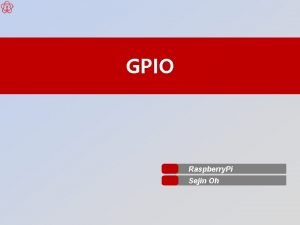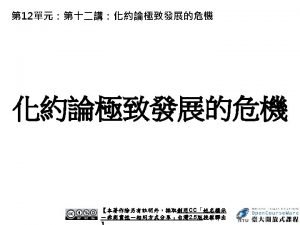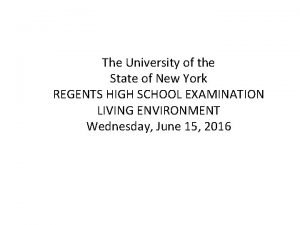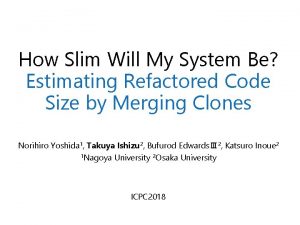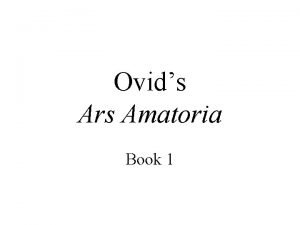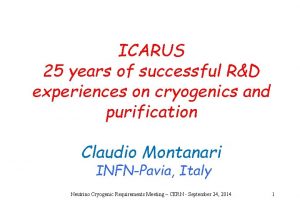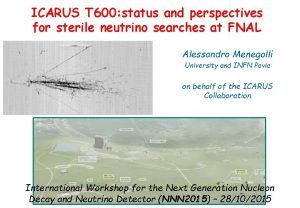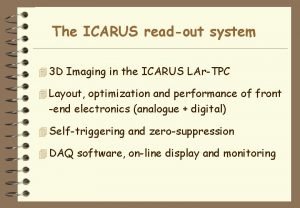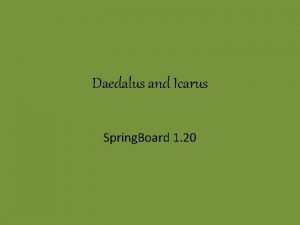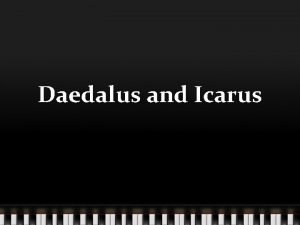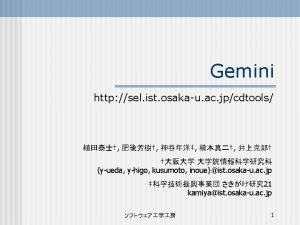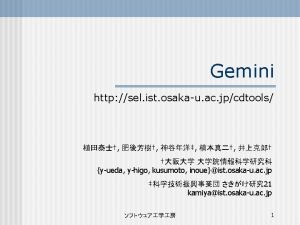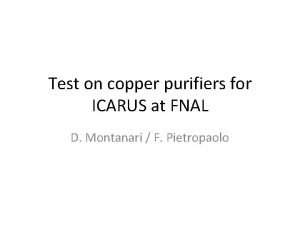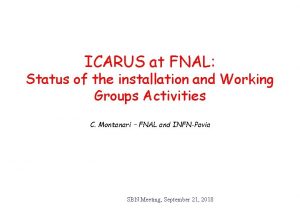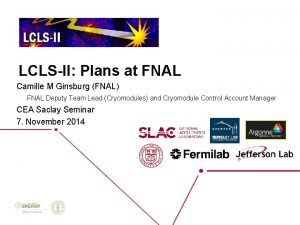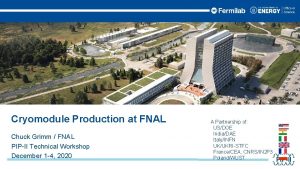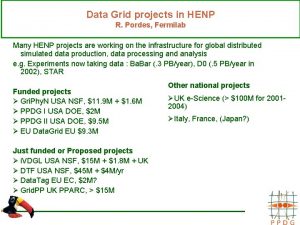ICARUS clone made at FNAL S Pordes FNAL
































- Slides: 32

ICARUS clone made at FNAL (S. Pordes - FNAL May 13 th 2006) Liquid Argon Purity Monitor Testing Bonnie Weiberg TRAC Program Summer, 2015

Purpose • To compare the Cathode and Anode signals for the three quartz fibers bundled together vs. each one individually • To measure the signal difference when an extension fiber was added via a connection through a PEEK coupler. • To check the Photocathode by changing the fiber holders inside the Purity Monitor.

Experimental Setup • Purity Monitor Diagram • Optical Fibers are made of Quartz, surrounded by A Polyimide buffer. • The Cathode is gold plated aluminum.

Experimental Setup • Xenon Flash lamp • Flash lamp is Newport/Oriel Model 6427 Xe, 3 x 2. 5 mm Large Bulb, 5 J, 60 W, 9 ms Pulse width, 60 Hz Flash lamp • Note that Au Work function is 5. 1 e. V • λ < 250 nm to extract an electron

Experimental Setup • Oscilloscope, Low and High Voltage • Arm provided by Dr. Alan Hahn.

Experimental Procedure • After setting the Xenon Flash Lamp to 5000 m. J and 1 Hz, I adjusted the Cathode voltage to -100 Volts, and the Anode voltage to 400 Volts, producing an electric field of 500 Volts. • I inserted the three fibers into the fiber holder and when they were against the flash lamp, I recorded the peak signals for both the cathode and anode. I repeated this procedure five times, removing the fibers completely, then reinserting them into the holder. • I repeated the above procedure for each of the three individual fibers, five times each.

Experimental Procedure • Screen shot of the Oscilloscope

Experimental Data • Data Collected on June 26, 2015:

Experimental Data • June 26, 2015 Continued:

Experimental Data • Data Collected on June 30, 2015:

Experimental Data • June 30, 2015 Continued:

Experimental Data • After attaching a 1 foot fiber segment to fiber one using a PEEK coupler, the following data was collected:

Experimental Procedure • To check the individual fibers for their light transmittance, each fiber was placed into a Photodiode and the current was measured.

Experimental Data Maximum Current Measured Using the Photodiode Fiber 1 -51. 2 m. A Fiber 2 -71. 3 m. A Fiber 3 -59. 2 m. A

Experimental Procedure • The fiber holders were then rearranged inside the Photocathode to check for cathode integrity. • Their original order was: • Holders 1 & 3 were switched.

Experimental Data • July 2, 2015:

Experimental Data • July 2, 2015, continued:

Experimental Results • Based upon the first two days of testing, fiber one produced the strongest cathode and anode signal of the three fibers. The highest peak value of -71. 3 m. V was measured on the first day of the purity monitor being under vacuum at 6. 5 x 10 -6 torr. • Adding a fiber extension using a PEEK coupler and set screws decreased the cathode signal by a factor of 20. • Using optical grease inside the coupler did not help the signal strength.

Experimental Results • The Photodiode procedure proved that the fibers are all transmitting light at similar levels. • Switching the fiber holders at the Photocathode caused the signals to decrease. For fibers 1 & 2, the amount of electrical noise produced caused the cathode signal become positive. • Fiber 3 had the strongest signal, averaging -2. 9 m. V when it was placed in the original position of Fiber 1 on the Photocathode. This small signal is 18 times smaller that the initial data average.

Conclusions • The data collected is much lower in voltage compared to data collected by Dr. Hahn in November, 2014. • Using a coupler produced a decrease in the cathode and anode signals. • The Photodiode allowed for the checking of similar signals through each fiber. • Switching the fiber holders on the Photocathode produced a huge decrease in signal strength and a large increase in electronic noise. • The experimental procedure will be repeated after a new Photocathode is installed. • Further investigation of the cleaving process of the Quartz fibers, including the possibility of removing the polymer protective coating, is needed to see if the signals can be amplified.

Experimental Adjustment • A new Photocathode was installed on July 7 th by Mark Ruschman. • The system was returned to the vacuum chamber and the chamber evacuated. • Data was once again collected using the aforementioned procedure, with the same fibers, listed earlier.

Experimental Data – July 8 th, 2015

Experimental Data – July 8 th, 2015

Experimental Data – July 8 th, 2015 • A 32. 9 cm Extension of fiber was connected to the long optical fiber with a PEEK coupler, held in place with Teflon screws.

Experimental Data – July 16 th, 2015 • After the apparatus sat for over a week, under vacuum, base line readings were again measured. Due to the new signal strength, the values are reported in Volts (V), not millivolts (m. V)

Experimental Data – July 16 th, 2015

Experimental Data – July 17 th, 2015 • Mark Ruschman made adjustments to his cleaving device and cut new ends to the long fibers. Measurements were again made following the original procedure.

Experimental Data – July 17 th, 2015

Experimental Data – July 17 th, 2015 • A 27. 30 cm Extension of fiber was connected to the long optical fiber with a PEEK coupler, held in place with Teflon screws.

Experimental Data – July 17 th, 2015 • Measurements were also made with a 29. 72 cm Extension of fiber, connected to the long optical fiber with a PEEK coupler, held in place with Teflon screws.

Conclusions - #2 • Changing the Photocathode resulted in a huge increase in signal from both the cathode and the anode. • Using a coupler produced a decrease in the cathode and anode signals. • Further investigation of the cleaving process of the Quartz fibers, including the possibility of removing the polymer protective coating, is needed to see if the signals can be amplified when a PEEK coupler is used. • A polishing procedure may also be added to help increase signal strength when using a coupler.

References • 1. “Purity Monitor - Description and Experience at Fermilab. ” S. Pordes - FNAL May 13 th 2006. • 2. “Preliminary Results from Scan of Flash Lamp Radiation Pattern with a Quartz Fiber Mounted on an Adjustable three axis table. ” AAH + MR, November 20, 2015 • 3. Polymicro Technologies Silica/Silica Optical Fiber FV Specification Sheet, Molex, 2013.
 Fermilab webmail
Fermilab webmail Lets clone a mouse
Lets clone a mouse 라즈베리파이 gpio
라즈베리파이 gpio Scientists show dna from
Scientists show dna from Clone relationship dynamics 365
Clone relationship dynamics 365 Dr cheriyath
Dr cheriyath Human clone
Human clone Clone evolution code
Clone evolution code Zerto commit policy
Zerto commit policy Clone stamp tool photoshop definition
Clone stamp tool photoshop definition Plenty of fish clone
Plenty of fish clone Cypop clone
Cypop clone The molecules used to cut copy and connect the dna
The molecules used to cut copy and connect the dna Human clone
Human clone Wordle map
Wordle map Cdna library diagram
Cdna library diagram Slim clone thickest year
Slim clone thickest year Ratis ovid est
Ratis ovid est Landscape and the fall of icarus
Landscape and the fall of icarus Icarus electronics
Icarus electronics Omniscient
Omniscient Consultorio familiare icarus
Consultorio familiare icarus Story of icarus summary
Story of icarus summary Icarus b the beginning
Icarus b the beginning Cryogenic research icarus
Cryogenic research icarus Icarus 600
Icarus 600 Icarus
Icarus Theme in daedalus and icarus
Theme in daedalus and icarus Icarus first cohort
Icarus first cohort Daedalus and icarus setting time
Daedalus and icarus setting time Ovid metamorphoses icarus
Ovid metamorphoses icarus Icarus poem
Icarus poem Dionysus theoi
Dionysus theoi


